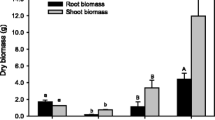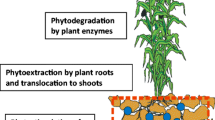Abstract
Purpose
The remediation of soil polluted by polycyclic aromatic hydrocarbons (PAHs) is of great importance due to the persistence and carcinogenic properties of PAHs. Phytoremediation has been regarded as a promising alternative among suggested approaches. For the establishment of highly effective remediation method and better understanding of the remediation mechanisms by plants, the potentials of three plant species and their planting patterns on the remediation efficacy were studied by pot experiments.
Materials and methods
Soils were amended with phenanthrene (Phe) or pyrene (Pyr) at five levels ranging from 0∼322 mg kg–1, then incubated for 30 days. At each level of PAHs, four treatments were set as: (a) treatments 1, no plant and microbe-inhibited with addition of 0.1%NaN3; (b) treatments 2, no plant and without the addition of NaN3; (c) treatments 3, microbe-inhibited and planted; (d) treatments 4, planted and without inhibition of microbes. For each planted treatment, single cropping of rape (Medicago sativa), alfalfa (Brassica campestris), and white clover (Trifolium repens), and mixed cropping of rape with alfalfa and white clover were adapted. Seedlings of 7 days old were then cultivated. After 70 days cultivation, soil and plant of each treatment were sampled for analyses of PAHs.
Results and discussion
Rape, alfalfa, and white clover all significantly promoted the degradation of PAHs in soils; alfalfa and white clover showed higher efficiencies for the removal of PAHs. Averagely, about 41.46% of Phe or 33.69% of Pyr were removed from soils after 70-day plantation of alfalfa, and 38.75% of Phe or 36.29% of Pyr removed by white clover, as compared to the much lower degradation rates of 22.57% of Phe or 18.24% of Pyr for non-planted controls. Mixed cropping significantly enhanced the remediation efficiencies as compared to single cropping; about 74.87% of Phe or 62.81% of Pyr were removed by mixed cropping of rape and alfalfa, and 72.01% of Phe or 68.44% of Pyr by mixed cropping of rape and white clover.
Conclusions
The presence of vegetation significantly promoted the dissipation of Phe or Pyr in soils and remediation efficiency varied greatly among plant species and cropping patterns. Rape had the lowest ability for the removal of PAHs, while alfalfa showed highest ability for the remediation of Phe and white clover was most effective for Pyr. Mixed cropping of rape with alfalfa or white clover was however far better for the remediation of soil PAHs than single cropping.


Similar content being viewed by others
References
Anderson TA, Guthrie EA, Walton BT (1993) Bioremediation in the rhizosphere. Environ Sci Technol 27:2630–2637
Chen YC, Banks MK, Schwab AP (2003) Pyrene degradation in the rhizosphere of Tall Fescue (Festuca arundinacea) and Switch grass (Panicum virgatum L.). Environ Sci Technol 37:5778–5782
Child R, Miller CD, Liang Y, Narasimham G, Chatterton J, Sims RC, Britt D, Anderson AJ (2007a) Polycyclic aromatic hydrocarbon-degrading Mycobacterium isolates: their association with plant roots. Appl Microbiol Biotechnol 75:655–663
Child R, Miller CD, Liang Y, Sims RC, Anderson AJ (2007b) Pyrene mineralization by Mycobacterium sp strain KMS in a Barley rhizosphere. J Environ Qual 36(5):1260–1265
Chiou CT, Sheng GY, Manes M (2001) A partition-limited model for plant uptake of organic contaminants from soil and water. Environ Sci Technol 35:1437–1444
Corgie SC, Joner EJ, Leyval C (2003) Rhizospheric degradation of phenanthrene is a function of proximity to roots. Plant Soil 257(1):143–150
Daniele F, Ivano V, Sun CG, Colin E, Snape CM, Anthony EF (2004) Source apportionment of polycyclic aromatic hydrocarbons in acoastal lagoon by molecular and isotopic characterization. Mar Chem 84:123–135
Gao YZ, Zhu LZ (2004) Plant uptake, accumulation and translocation of phenanthrene and pyrene in soils. Chemosphere 55:1169–1178
Gao YZ, Zhu LZ (2005) Phytoremediation for phenanthrene and pyrene contaminated soils. J Environ Sci (China) 17(1):14–18
Gerhardt KE, Huang XD, Glick BR, Greenberg BM (2009) Phytoremediation and rhizoremediation of organic soil contaminants: potential and challenges. Plant Sci 176:20–30
Haritash AK, Kaushik CP (2009) Biodegradation aspects of polycyclic aromatic hydrocarbons (PAHs): a review. J Hazard Mater 169:1–15
Huang XD, El-Alawi Y, Donna MP, Bernard RG, Bruce MG (2004) Responses of three grass species to creosote during phytoremediation. Environ Pollut 130:453–463
Jennifer LK, John NK, Hung L, Jack TT (2005) The effects of perennial ryegrass and alfalfa on microbial abundance and diversity in petroleum-contaminated soil. Environ Pollut 133:455–465
Joner EJ, Leyval C (2003) Rhizosphere gradients of polycyclic aromatic hydrocarbon (PAH) dissipation in two industrial soils and the impact of arbuscular mycorrhiza. Environ Sci Technol 37:2371–2375
Khan AA, Wang RF, Cao WW, Doerge DR, Wennerstrom D, Cerniglia CE (2001) Molecular cloning, nucleotide sequence, and expression of genes encoding a polycyclic aromatic ring dioxygenase from Mycobacterium sp strain PYR-1. Appl Microbiol Biotechnol 67:3577–3585
Khan S, Hesham A, Gu Q, Liu S, He JZ (2009) Biodegradation of pyrene and catabolic genes in contaminated soils cultivated with Lolium multiflorum L. J Soils Sediments 9:482–491
Kipoponlou AM, Manoli E, Samara C (1999) Bioconcentration of polycyclic aromatic hydrocarbons in vegetables grown in an industrial area. Environ Pollut 106:369–380
Lee SH, Lee WS, Lee CH, Kim JG (2008) Degradation of phenanthrene and pyrene in rhizosphere of grasses and legumes. J Hazard Mater 153:892–898
Lewis HS, Schwab AP, Banks MK (2001) Phytoremediation of aged petroleum sludge: effect of irrigation techniques and scheduling. J Environ Qual 30:1516–1522
Liliana G, Maria AR (2004) Potential of extra cellular enzymes in remediation of polluted soils: a review. Enzyme Microb Technol 35:339–354
Liste HH, Alexander M (2000) Plant-promoted pyrene degradation in soil. Chemosphere 40:7–10
Macek T, Mackova M, Kas J (2000) Research review paper exploitation of plants for the removal of organics in environmental remediation. Biotechnol Adv 18:23–34
Maila MP, Randima P, Cloete TE (2005) Multispecies and monoculture rhizoremediation of polycyclic aromatic hydrocarbons (PAHs) from the soil. Int J Phytoremediat 7(2):87–98
Menzie CA, Potocki BB, Santodonato J (1992) Exposure to carcinogenic PAHs in the environment. Environ Sci Technol 26:1278–1284
Muratova A, Hübner T, Tischer S, Turkovskaya O, Möder M, Kuschk P (2003) Plant-rhizosphere-microflora association during phytoremediation of PAH-contaminated soil. Int J Phytoremediat 5(2):137–151
Pan SW, Wei SQ, Yuan X, Cao SX (2008a) Mechanisms of the removal and remediation of phenanthrene and pyrene in soil by dwarf lilyturf. Acta Ecologica Sinica (in Chinese) 28(8):3654–3661
Pan SW, Wei SQ, Yuan X, Cao SX (2008b) The removal and remediation of phenanthrene and pyrene in soil by mixed cropping of alfalfa and rape. Agri Sci China 7(11):101–110
Paterson S, Mackay D (1994) A model of organic chemical uptake by plants from soil and the atmosphere. Environ Sci Technol 28:2259–2265
Parrish ZD, Banks MK, Schwab AP (2005) Assessment of contaminant lability during phytoremediation of polycyclic aromatic hydrocarbons impacted soil. Environ Pollut 137:187–197
Reilley KA, Banks MK, Schwab AP (1996) Dissipation of polycyclic aromatic hydrocarbons in the rhizosphere. J Environ Qual 25:212–218
Ryan K, Miya MK (2001) Enhanced phenanthrene biodegradation in soil by slender oat root exudates and root debris. J Environ Qual 30:1911–1918
Schnoor JL, Licht LA, McCutcheon SC, Wolfe NL, Carreira LH (1995) Phytoremediation of organic and nutrient contaminants. Environ Sci Technol 29:318–323
Siciliano S, Germida JJ, Banks K, Greer CW (2003) Changes in microbial community composition and function during a polyaromatic hydrocarbon phytoremediation field trial. Appl Environ Microbiol 69:483–489
Tsao DT (2003) Overview of phytotechnologies. Adv Biochem Eng Biotech 78:4–50
Toner EJ, Lceyval C (2003) Rhizosphere gradients of polycyclic aromatic hydrocarbons (PAHs) dissipation in two industrial soil and the impact of arhuscular mycorrhiza. Environ Sci Technol 37:2371–2375
Walton BT, Anderson TA (1988) Structural properties of organic chemicals as predictors of biodegradation and microbial toxicity in soils. Chemosphere 17:1501–1507
Wang M, Jones KC (1994) Uptake of chlorobenzencs by carrots from spiked and sewage sludge-amended soil. Environ Sci Technol 28:1260–1267
Wang YX, Oyaizua H (2009) Evaluation of the phytoremediation potential of four plant species for dibenzofuran-contaminated soil. J Hazard Mater 168:760–764
Wilson SC, Jones KC (1993) Remediation of soil contaminated with polynuclear aromatic hydrocarbons (PAHs): a review. Environ Pollut 81:229–249
Xu SY, Chen YX, Wu WX, Wang KX, Lin Q, Liang XQ (2006) Enhanced dissipation of phenanthrene and pyrene in spiked soils by combined plants cultivation. Sci Total Environ 363:206–215
Yi H, Crowley DE (2007) Biostimulation of PAH degradation with plants containing high concentrations of linoleic acid. Environ Sci Technol 41(12):4382–4388
Acknowledgments
This research was financially supported by the National Scientific and Technological Supporting Program of China (2007BAD87B10-5), and by the “211” Ecology National Key Discipline of Southwest University.
Author information
Authors and Affiliations
Corresponding author
Additional information
Responsible editor: Jianming Xu
Rights and permissions
About this article
Cite this article
Wei, S., Pan, S. Phytoremediation for soils contaminated by phenanthrene and pyrene with multiple plant species. J Soils Sediments 10, 886–894 (2010). https://doi.org/10.1007/s11368-010-0216-4
Received:
Accepted:
Published:
Issue Date:
DOI: https://doi.org/10.1007/s11368-010-0216-4




